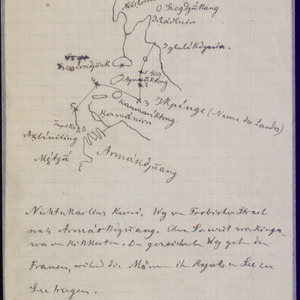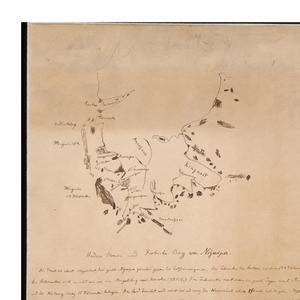Indigenous Navigation and Cartography
Both of these maps are from a Smithsonian collection of maps drawn by German/American anthropologist Franz Boas and one (or multiple) unidentified Inuit colleagues. The comments on the maps are either in Inuktitut or German, and the handwriting on the map labels and comments notably varies, showing that there is definitely collaboration occurring. This collection shows a co-production of knowledge and a collaboration between different ways of knowing: indigenous and Western knowledge are combined to create the most accurate depictions of Baffin Bay and the surrounding areas.
However, in this Smithsonian collection, there is also some inadvertent erasure of indigenous knowledge in that the Inuit collaborators are unnamed. There is no clear demarcation between maps utilizing indigenous knowledge and those that do not. Furthermore, the collection is called “Maps of parts of Baffin Island drawn by Eskimos, and related notes by Franz Boas,” and in the description, it says that some maps “include a short text in Eskimo.” This is problematic for two reasons: 1) Eskimo is a racially charged, derogatory word in Canada, where these maps have been drawn, and 2) Eskimo may be a language family, but it is not a language— the language spoken is likely Inuktitut.
The first map uses indigenous place names and handwriting that is notably different than Boas’ (and not in German), indicating that this map of the Hudson Strait (at the very southern end of Baffin Bay and on the Southern shore of Baffin Island) and notes are likely drawn and written by the unidentified Inuit colleague rather than Franz Boas. The second map appears to be drawn by both Franz Boas and his Inuit colleague due to the mix of handwriting styles and the German shorthand commentary. This map shows co-production at work in an effort to map Frobisher Bay and other elements of the Baffin Island coastline as accurately as possible.
Though knowledge co-production is something to be celebrated, it is important to recognize how it can— and often does— lead to indigenous erasure. This collection of images shows both the positive and negative sides of this co-production and also emphasizes how museum curators can inadvertently perpetuate harmful stereotypes through language use.


